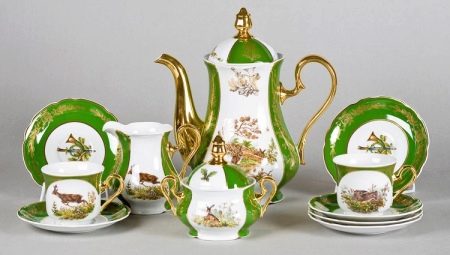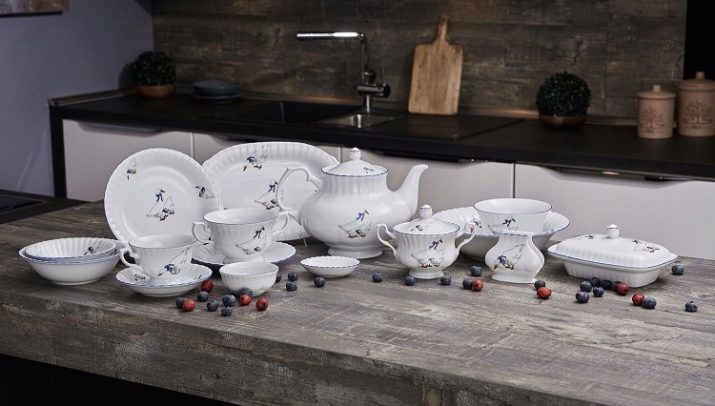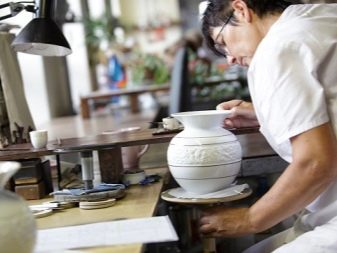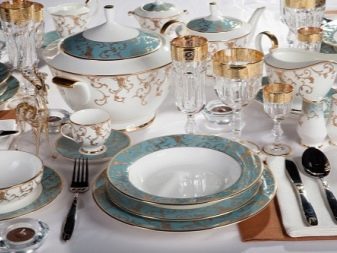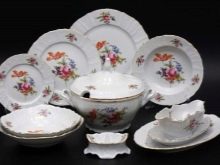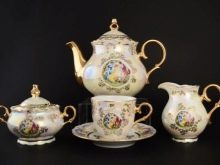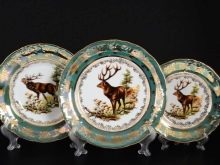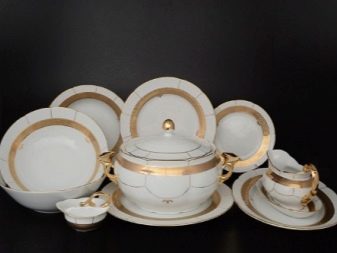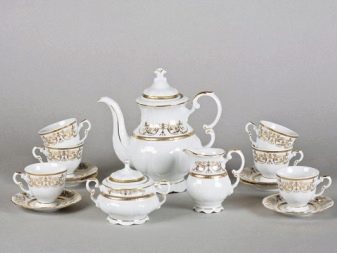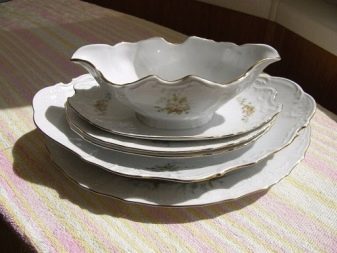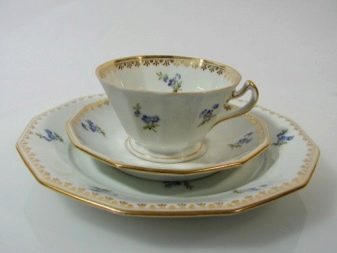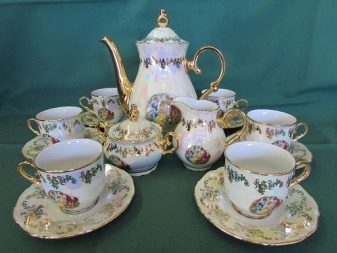Czech porcelain is deservedly known all over the world, and is especially loved by the people of Russia. However, in order not to get a fake at the time of purchase, it is important to understand the characteristics of such dishes and to know who produces them.
A bit of history
The history of Czech porcelain begins at the end of the XVIII century, and more precisely, in the 90s of the century. The first specimen of Czechoslovak porcelain was presented near Karlovy Vary, where, shortly before this, a kaolin or white clay deposit was discovered. Since the main raw materials needed for the production of porcelain turned out to be high-quality, the region quickly became the main center for the production of this type of cookware in the Czech Republic. Moreover, the Czech clay itself was transported to other countries engaged in the production of porcelain.
Since at that time this territory was under the control of the Germans, it is not surprising that the German manufacturing technology was chosen. Besides, most of the factories responsible for the production of Czech porcelain were owned by German industrialists. However, the cost of Czech tableware was still lower, being at the same quality level as English or German porcelain. In fact, the secret of the popularity of Czech porcelain was in the combination of the advantages of both countries. From the Czech side it was a high-quality and reliable source material, and from the German side it was a time-tested recipe for making dishes, the experience of craftsmen and the mastery of the technique of elegant painting.
Advantages and disadvantages
Cookware from the Czech Republic has a number of significant advantages, which explains its popularity throughout the world. Products have high strength, and during operation you should not worry because of the chips - they are unlikely to appear. High-quality glaze is not afraid of microwave radiation, allows you to wash products in a dishwasher, as well as use them at high temperatures. The impact of cutlery does not cause stains on the surface of the plates, which is also a plus. Although the price of Czech porcelain can not be called small, it is significantly lower than in the case of German or English copies.
The downside is the design, which not every buyer likes. Some rudeness and monotonous plots often become disadvantages of this type of cookware. The price of Czech porcelain, rather, refers to the middle segment. For example, a Leander cake trowel will be purchased for a thousand rubles, and a table set for six persons from the same company will cost approximately 23 thousand rubles.
Varieties of dishes
Czech porcelain is most often purchased in the form of tea sets or table sets, combining the maximum number of objects, and not just plates and cups with cups. For example, a tea set for 6 persons can consist of 15 items, including a teapot, a sugar bowl, a milk jug, and a set of saucers with cups. A typical table set for 6 persons consists of 24 items. In six instances in this case, various plates are presented: deep, shallow and dessert. In addition, the package includes an oval dish, a round dish, a pair of salad bowls, a salt shaker, and a round sauce pan on a stand. Of the unusual dishes related to Czech porcelain, mention should be made of a bread box, a bowl for bones, a butter dish, a set of spices, a container for oil, lemongrass, napkin rings and many others.
Theme
Czech porcelain produced by different factories combines the use of the same common subjects. For example, quite often on the plates there is a field flower, or rather, variations of the plant element resembling an onion. Flowers are most often painted in a traditional blue shade. Equally popular are the sets with biblical scenes and sketches that are inspired by the Renaissance style. All of them are united under the single name "Madonna".
Pink rose porcelain is decorated with gold leaf and flower arrangements. However, tourists from all over the world bring home mugs and plates with Czech geese, decorated with blue bows and arranged in pairs.
We must not forget about the "green hunt" - various plots of this popular pastime.
Colors
The essence of the technology of Czech porcelain is that the mixture itself has a pleasant pinkish color. If you look at the fragments of the product, you can find a pink tint even from the inside. This, by the way, makes it possible to distinguish Czech porcelain from common English, German, and French, which will be white at the breaks. European manufacturers attach color to their products by applying further colored glaze. However, most often Czech porcelain looks milky white.
Manufacturers Overview
Manufacturers of Bohemian porcelain are well known throughout the world, as they have been operating for many years and are a guarantor of product quality. Klasterec-Thun Plantoperating since 2009, is considered the largest in the Czech Republic. Manufacture includes porcelain for home, restaurants and other catering establishments. Previously, the company operated under the brand name Thun, which began its work in 1794. One of the popular works of the time was Porcelain "Tunsky" servicecreated for the Vienna Imperial Court.
Other famous Thun creations include sets "Nicole", "Clea", "Constance" and "Opal". Currently, the manufacturer is increasingly modifying the classic design in favor of modern trends, for example, adds avant-garde notes. Special children's services are also popular.
Leander Porcelain It was first manufactured in 1907, in Karlovy Vary. At the end of the Second World War, the company took under the patronage of the state, and the dishes of the plant began to be exhibited at international fairs. Currently, the company produces several lines of dishes: for general use, for hotels and restaurants, as well as luxury items decorated with hand-painted. The most popular services of this brand include Windsor, Sonata, Sabina and Victoria. One of the most famous designs of Czech porcelain - geese, is made here.
Factory Concordia Lesov was founded in 1888. His main specialization was porcelain bernadotte. A characteristic feature of the technology used is small bas-reliefs, very clear and neat. Products are made in white or ivory. Bernadotte is presented in various variations: from fruit slides to napkin holders and spatulas for cakes. Buyers can find and caskets, and ashtrays, and various parts for home decoration.
Factory brand Haas Czjzek It was founded in 1792, and therefore is considered one of the oldest. The company's products is a set of dishes for serving the table, decorated with moldings. The most famous brand is considered set of "Simon". In addition to hand painting, objects are decorated with the use of acid engraving and other technologies. Cookware is of high quality and durability, the ability to wash it in a dishwasher and easily place in a microwave. Finally, it is impossible not to mention the dishes brand Bohemia Porcelain - one of the oldest Czech companies.
How to choose?
When choosing porcelain made in Czechoslovakia, it is important to carefully consider and touch the selected products. This porcelain is pleasant to touch, as it is absolutely smooth, without any dents or grooves. If you examine, for example, a cup using a bright light source, you will find that it is slightly translucent. On the back of the dishes you can always find a kind of brand - a circle left after firing. Sometimes several points are left next to it, which are left from the needles, on which the dishes were hung.
In a standing position, the dishes do not swing, but manifest themselves steadily. In the case when a porcelain product is a product of a certain plant, the emblem of the latter is applied under the glaze, and on each product without exception. Other drawings are drawn very carefully and evenly, without any chips. In general, it is worth remembering that real Czech porcelain is not too cheap, but its fakes with a lower price abound.
While in the store, you should definitely check the purchased item, especially if it is bought as a gift.
Care features
Czech porcelain is not recommended to be washed using conventional dishwashing detergents, since in most cases coarse abrasive particles adversely affect the surface condition - it becomes cracked and loses its original color. It is much better to use baby soap and a little heated water in a separate container. The state of the dishes will be adversely affected by both pressurized water coming from the flow valve and the soaking of individual specimens.
After completing the wash, cups and plates should be immediately wiped off with a soft cloth or rag, in order to avoid streaks.
Optimal storage of Czech porcelain occurs in glazed windows, protected from dust and humidity.
You can find out how Czech porcelain is made by looking at the video below.
